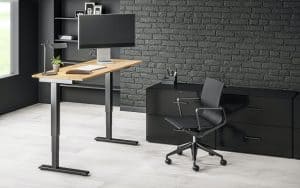Improper posture paired with sitting at a desk for long hours and looking at a screen can lead to minor and severe black problems.
But, does this mean that there’s nothing you can do to improve your situation? That’s definitely not the case. There are strategies that can help you improve your posture and exercises that can help you reduce your back pain.
In this article, we’ll discuss both in more detail so you can learn how to stop slouching at your desk once and for all.

The Link Between Back Pain and Slouching
Even though office jobs are one of the safest jobs in terms of risk of workplace accidents, they can also be the cause of some of the most common long-term health conditions related to problems with the back and spine.
“Sitting disease” is common among people who sit for prolonged periods. This can lead to spine misalignments as well as a number of other musculoskeletal disorders even if a person is exercising consistently.
The reasons why improper posture can cause these health problems are as follows:
- The longer you sit, you’re more likely to slouch and keep your spine in a position that’s less than ideal
- Crossing your ankles and legs can cause hip misalignment
- Not positioning your monitor at eye level can cause neck strain
- Sitting for long periods of time restricts nutrient and blood flow to your spinal discs as well as increases their wear and tear
But fear not, as you can prevent long-term damage by simply learning how to maintain proper posture.
How to Stop Slouching at Your Desk?
We’ll tackle how you can stop slouching from a few different aspects in this article in order to help you improve your posture:
- Proper posture
- Having ergonomic support to improve posture
- Changing positions frequently
- Doing exercises that improve posture
Proper Posture
In order to stop slouching, you must first pay attention to maintaining proper posture. We often get so caught up in the work that we’re doing that we slowly start to bend our back and end up slouching.
So, the first thing we should keep in mind is to become more aware of our posture throughout the day and correct it when necessary. Pay attention to how you’re sitting, standing, and walking, and remember to have good posture while you’re doing all these activities.
Now let’s dive deeper into how you should be maintaining good posture.
Standing
Maintaining a good posture while standing is just as important as doing so while sitting. Remember to:
- Keep your shoulders relaxed, pull them back just a bit
- Stand as if a string is gently pulling you upwards with your head at a neutral position and your ears over your shoulders
- Keep your weight on the balls of your feet and shift the weight from your toes to your heels if you’re standing for a longer period, or shift the weight between one foot and the other
- Tuck your stomach and bend your knees slightly
Sitting
In order to use good posture while sitting, make sure that you:
- Purchase a chair that suits your height and enables you to have your feet flat on the floor
- While sitting, make sure that your shoulders are relaxed and not hunched, your legs aren’t crossed, and the level of your knees is equal to or slightly higher than your hips.
- Your back should rest in the chair to support your spine
- Your head shouldn’t bend forward and your ears should be aligned with your shoulders
- Your computer should be at eye level and your neck shouldn’t bend forward or backward
Practicing Neutral Posture
Good posture will become second nature with practice.
Neutral posture means keeping your spine and your body as straight as possible and this can be achieved even as you’re sitting at your desk.
Ergonomic Support Improves Posture
Ergonomic furniture support the neutral posture of the back and spine and reduce the chances of developing musculoskeletal disorders. Below we’ll give you examples of the most commonly used tools that help you maintain good posture
Ergonomic Chair
One of the best investments you can make for your back is to invest in a high-quality ergonomic chair. This chair keeps your spine, hips, and shoulders aligned and can prevent back and spine problems.
Footrest
As we’ve mentioned above, when sitting at your desk, your knees and waist should be at a 90-degree angle and your feet should lie flat on the floor. If this isn’t the case, you should purchase an ergonomic adjustable footrest to help your body maintain good posture as you work.
Laptop Stand
If your computer screen isn’t at the right height, you may experience neck pain. Use either a laptop stand to lift your laptop, or add a few books under your screen if you’re using a desktop computer to keep the screen at eye level.
Back Support
If your chair doesn’t have enough back support you can add a lumbar support cushion to help your lower back stay in a good position.
Changing Positions Frequently
Sitting in one position for too long isn’t a good idea. If possible, you should alternate between a sitting and standing desk and maintain good posture in both positions. Standing desks offer many benefits, which we cover in this article.
You should also make sure that you take movement breaks every 30 minutes and stretch, or do some light exercise. If you’re not that good at remembering when you should take a break, set a reminder that will tell you when it’s time to change positions. You can even set an additional timer that will remind you to check your posture every once in a while.
Doing Exercises that Improve Posture
You don’t have to run a marathon everyday. Just some light stretching and a few simple exercises that will help support good posture. We’ve covered the most beneficial exercises that will help you improve your posture below.
Plank
Core muscles (abdominal, pelvic, and lower back muscles) are essential for maintaining proper posture, so strengthening them should be one of your top priorities. The best exercise for strengthening these muscles is the plank. This exercise and all its variations will help you relieve the pain from sitting for too long at your desk.
Child Pose
This pose is one of the most commonly practiced poses in yoga and it’s perfect for supporting good posture. It helps you stretch your spine, lower back, glutes and hamstrings.
Wall Slide
The wall slide is perfect for getting your body back to proper posture if you’ve been sitting stiffly at your desk for a long period of time. It can also help you to relieve all the tightness in your shoulders and neck.
Shoulder Blade Squeeze
Another great exercise idea that helps you improve your posture is the shoulder blade squeeze. When doing this exercise you can feel instant relief in your upper back, and it stretches the chest muscles as well.
Bridge
On the list of core strengthening exercises, the bridge is the second best one. It helps you strengthen the glutes and core muscles as well as relieve some pressure from your lower back.
Benefits of Having Good Posture
Since we’ve covered everything you can do to improve your posture, we should finish by mentioning what you stand to gain if you follow our advice. There are numerous benefits that can come from good posture, and some of the most notable ones include:
- Better balance in old age. If you maintain good posture in your youth, you’re less likely to fall or lose your balance as you age.
- Reduce tension headaches. Improper posture can also lead to a stiff neck and tension headaches, and both can be avoided by taking care of your spine.
- Reduce back pain. You can’t ever fully get rid of back pain since this becomes more and more common as you age, but you can reduce the pressure and tension that builds up in your spine from improper posture.
- Prevent a hunch from developing. As people age, a hunch can develop on the back, and the risk increases if you don’t have good posture.
- Lower the risk of injury. Bad posture doesn’t only affect your spine and back, but also your muscles, joints, and ligaments which are more prone to injury as a result.
- Breathe better. When you have good posture, your lungs are able to expand fully which means your breathing will be improved.
- Have better circulation. Apart from harming your spine and back, slouching also compresses your vital organs. This means that the blood doesn’t flow as easily as it should.
We hope that you’ll implement our advice and keep your back and spine as healthy as possible.





